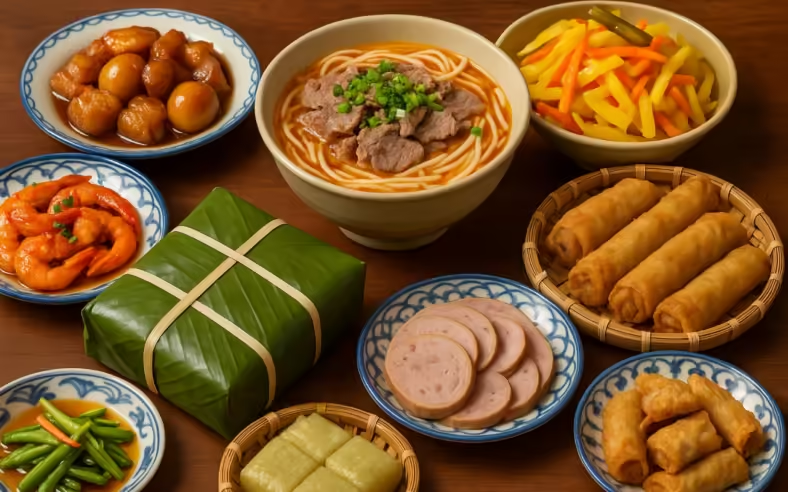
Vietnamese Tet Food: 12 Essential Dishes for the Lunar New Year+ PDF Guide
If you’re interested in Vietnamese Tet food, this post will introduce you to the top 12 essential dishes for Tet in Vietnam. We’ll give you a clear insight into the ingredients and cooking methods for these traditional foods. Plus, we’ll explore the significance of each dish during the Tet celebration. We’ll also introduce some popular Vietnamese Lunar New Year snacks that you won’t want to miss. At the end of this post, you can download a free PDF listing all the traditional foods for the Vietnamese New Year.
Introduction
Top 12 essential dishes
Cooking methods and ingredients
Tet food preparation
Conclusion
Vietnamese Tet food FAQs
Bonus section

Overview
What is Tet? An overview of the Lunar New Year in Vietnam
Tet, also known as Tet Nguyen Dan or the Vietnamese Lunar New Year, is the most significant holiday in Vietnam. It marks the transition from the old year to the new year according to the lunar calendar and usually falls between late January and early February. Tet isn’t just about welcoming the new year—it’s a time for family reunions, honoring ancestors, and wishing for health and prosperity in the year ahead.
During Tet, Vietnamese people follow traditional customs like cleaning their homes, visiting ancestral graves, preparing special offerings, celebrating New Year’s Eve, exchanging well-wishes, and giving children lucky money (li xi). Traditional Vietnamese Tet foods such as banh chung (chung cake), ga Luoc (boiled chicken), and xoi gac (red sticky rice) play a vital role in Tet celebrations.
The significance of Vietnamese lunar new year food
For Vietnamese people, traditional Tet food is more than just a meal—it’s filled with deep cultural and spiritual meaning. Each dish symbolizes wishes and hopes for the upcoming year.
For example, banh chung and banh tet represent gratitude to ancestors and the balance of heaven and earth with their square and round shapes. Dishes like xoi gac (red sticky rice) symbolize luck and prosperity, while dua hanh (pickled shallots) stand for health. Preparing and sharing these foods strengthens family bonds, shows respect for heritage, and expresses the desire for a prosperous and joyful new year.
In this way, Vietnamese Tet food is not just about food; it’s a powerful symbol of tradition, unity, and optimism during the Lunar New Year celebration.
Purpose of the post
The goal of this post is to provide you with a clear understanding of Vietnamese Lunar New Year food and the meaning behind each dish. We’ll also introduce you to the key ingredients and traditional Vietnamese spices used in these recipes. By the end of this post, we hope you’ll have a deeper appreciation for the unique flavors and rich culture of Vietnamese cuisine.
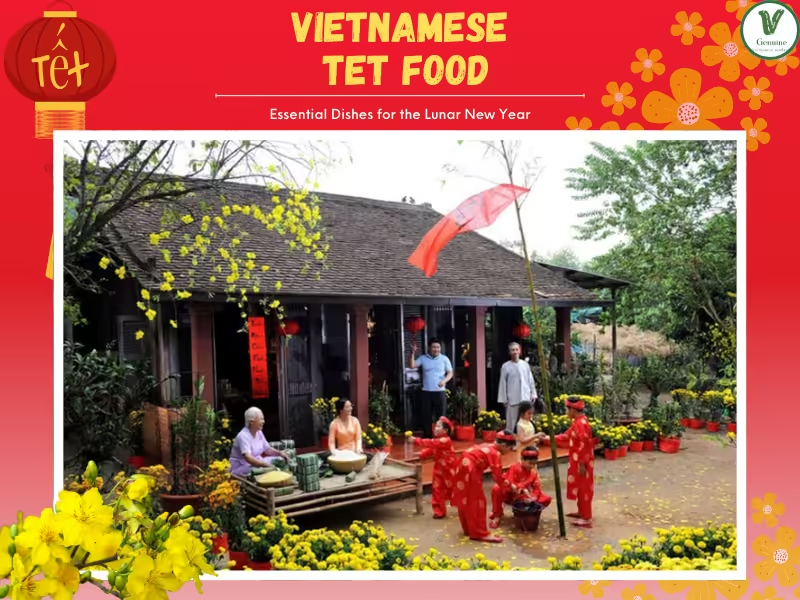
A picture of a family wrapping Chung cakes for Tet, with children playing in traditional Vietnamese outfits (Source: Collected)
12 essential dishes in Vietnamese Tet food
Boiled chicken
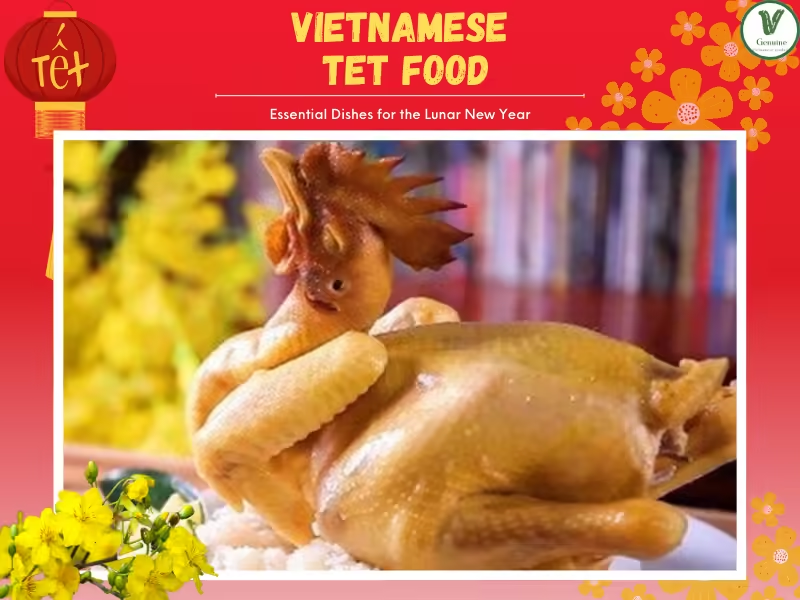
A picture of a chicken offered by Vietnamese people on their ancestral altar during Tet (Source: Collected)
Overview
Vietnamese name: Ga luoc
Ingredients: chicken, Vietnamese coriander, onions, carrots, bean sprouts, lime leaves, salt, pepper, monosodium glutamate (MSG), chili powder, fresh chili, lime.
Significance: It expresses respect for ancestors and prays for favorable weather and good fortune.
Vietnamese people hold chickens in high regard, seeing them as symbols of admirable qualities such as strength, courage, and resilience. Because of this deep respect, boiled chicken is an essential dish during Tet, often served on ancestral altars as an offering to honor their ancestors.
In Vietnam, preparing ga luoc (boiled chicken) for Tet starts with selecting a healthy, beautifully shaped chicken. Once chosen, the chicken is carefully slaughtered, and its insides are removed while keeping its form intact. The next step is to boil the chicken in hot water until it’s fully cooked. Once ready, it’s placed on the altar alongside other traditional Tet foods to honor ancestors.
After the ceremony, the chef shreds the chicken by hand into bite-sized pieces. They mix in Vietnamese spices like salt, pepper, MSG, and chili powder, along with fresh Vietnamese herbs such as Vietnamese coriander, chopped lime leaves, onions, carrots, and bean sprouts, finishing it off with a splash of lime juice. The result is a flavorful and vibrant dish.
Chung cake
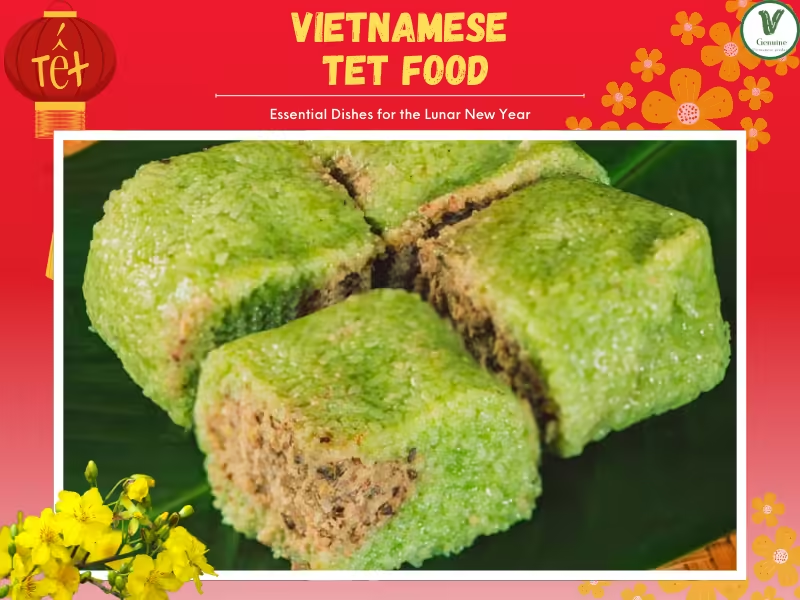
Chung Cake is a delicious traditional cake from Vietnam, featuring an outer layer of glutinous rice and a filling made of mung beans, pork belly, and some seasonings (Source: Collected)
Overview
Vietnamese name: Banh chung
Ingredients: Glutinous rice, mung beans, pork belly, salt, pepper
Special equipment: Dong leaves, thin bamboo strips, and a square mold.
Significance: Chung cake represents the Earth and symbolizes gratitude to ancestors, wishing for prosperity and happiness in the New Year.
Banh chung (chung cake) is an essential part of Vietnamese Tet celebrations. In the days leading up to Tet, family members come together to make this traditional dish. To shape the cake perfectly, a square mold measuring about 12 cm in length and width and 5 cm in height is used. Large green dong leaves are placed inside the mold to create an outer layer. The filling consists of sticky rice, with a center of seasoned pork belly and mung beans, flavored with salt and pepper. The cake is wrapped securely using thin bamboo strips before being boiled until fully cooked.
In Vietnam, people enjoy eating banh chung with pickled shallots on the side. Pickled shallots are small onions that have been soaked in a vinegar solution, giving them a tangy and slightly sweet flavor. T
In Vietnamese culture, banh chung symbolizes the Earth, while its ingredients represent the life of plants and animals that thrive on it. Making banh chung for Tet is a way to express gratitude to the heavens and the earth for a bountiful life. This cake is placed on the altar to honor ancestors, remembering them during the New Year celebrations.
After Tet, many families in Vietnam have leftover banh chung. To make the most of it, they create a delicious dish called fried Chung Cake. It’s simple: they slice banh chung into pieces and fry them in hot oil until golden and crispy.
Red sticky rice
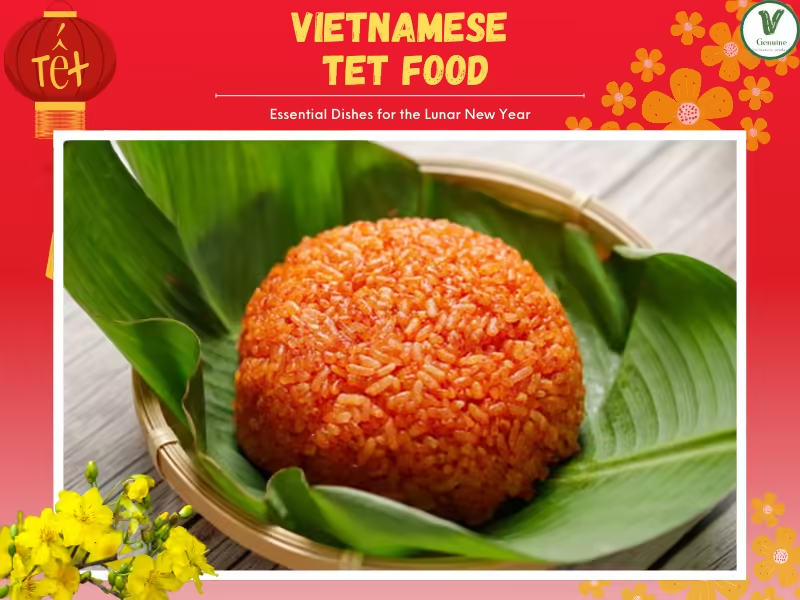
Red sticky rice symbolizes wishes for good luck and happiness in the coming year (Source: Collected)
Overview
Vietnamese name: Xoi gac
Ingredients: Glutinous rice, spiny bitter gourd, salt, rice wine
Significance: Xoi Gac is a beautiful dish that symbolizes luck and happiness.
To make xoi gac (red sticky rice), Vietnamese people start by soaking sticky rice overnight. A spiny bitter gourd is then cut in half, and the flesh is scooped out and mixed with a splash of rice wine. This vibrant mixture is combined with the soaked sticky rice along with a pinch of salt to give the rice a beautiful red color. The mixture is then steamed for about 30 to 45 minutes. Once it’s done cooking, you’ll have a stunningly red dish with a delightful aroma.
In Vietnamese culture, the color red symbolizes luck and happiness. That’s why xoi gac, with its beautiful red hue, is a must-have dish during Tet. This delicious sticky rice carries the hope for a joyful and prosperous New Year!
Vietnamese fried spring rolls
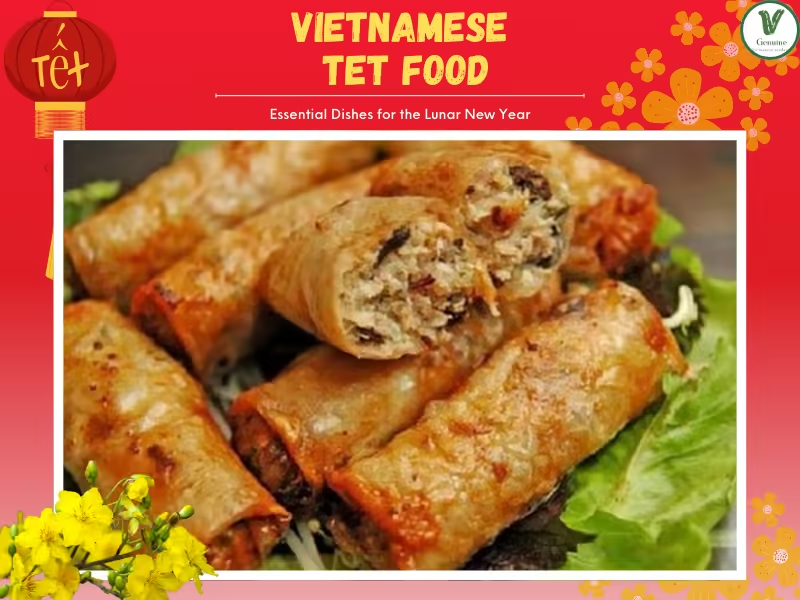
Vietnamese fried spring rolls are a beloved dish enjoyed by Vietnamese families during Tet (Source: Collected)
Overview
Vietnamese name: Nem ran (or cha gio)
Filling: Ground pork, eggs, carrots, kohlrabi, green onions, wood ear mushrooms, shiitake mushrooms, onions, black pepper, glass noodles
Fresh herbs: Lettuce, fish mint, thai basil, cucumbers
Dipping Sauce: Fish sauce, lime juice, chilis, garlic, green papaya, carrots, sugar.
Significance: Fried spring rolls symbolize harmony and love among family members.
Nem ran (fried spring rolls) are an essential part of Vietnamese Lunar New Year food. Vietnamese people use rice paper wrappers to enclose a portion of flavorful filling, rolling it up tightly while tucking in the sides to prevent any spills. Then, the rolls are fried in hot oil until they turn golden brown and crispy.
The filling is a flavorful mix of ground pork, glass noodles, eggs, carrots, kohlrabi, green onions, wood ear mushrooms, shiitake mushrooms, and onions, all seasoned with spices like pepper and fish sauce. The result is a crunchy, savory treat.
Fried spring rolls are more than just a delicious dish; they represent a warm family tradition. Preparing them often involves everyone coming together in the kitchen, creating a cozy atmosphere. Because of this, fried spring rolls symbolize the love and harmony that connect family members.
Caramelized pork and eggs
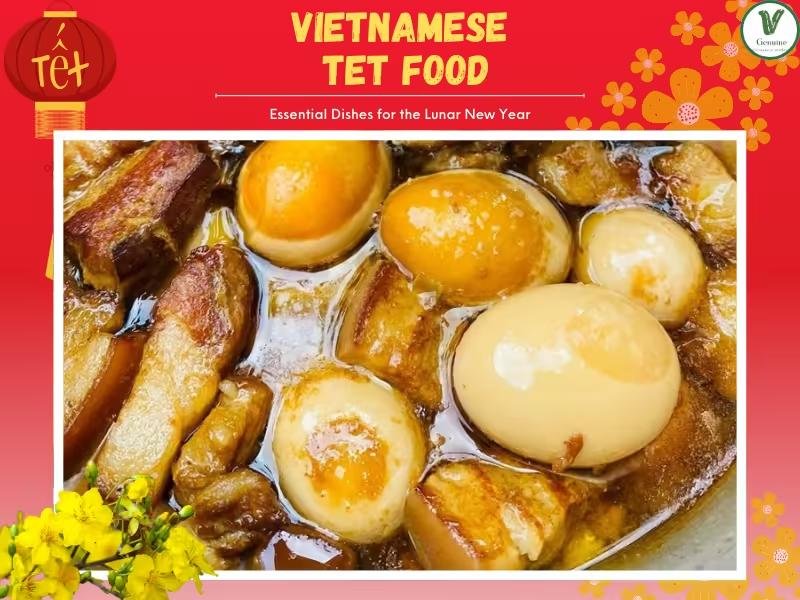
Caramelized pork and eggs is a popular dish during Tet in southern Vietnam. (Source: Collected)
Overview
Vietnamese name: Thit kho tau
Ingredients: pork belly, coconut water, duck eggs, shallots, garlic, sugar, monosodium glutamate (MSG), fish sauce, pepper.
Significance: This dish symbolizes the wishes for a prosperous and joyful year to come.
In Southern Vietnam, thit kho tau (caramelized pork and egg) is a must-have food for the Vietnamese New Year. This flavorful dish combines pork belly and duck eggs with a delightful mix of ingredients, including shallots, garlic, sugar, monosodium glutamate (MSG), fish sauce, and pepper. Coconut milk is also essential, enhancing the overall flavor and richness of the dish. The chef carefully simmers this savory mixture over low heat until the pork is tender and infused with all the delicious flavors. This dish is typically served with rice and reflects the hopes and dreams for abundance and joy in the year ahead.
Vietnamese pork roll
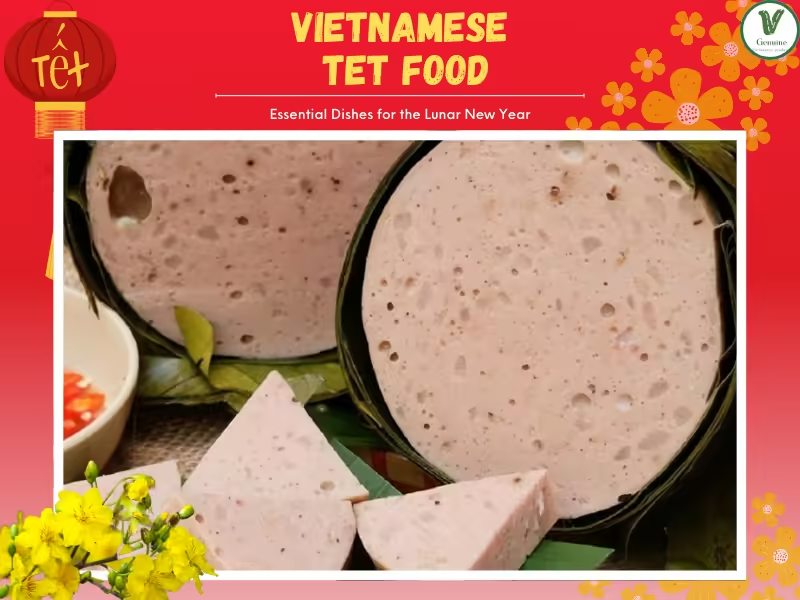
Vietnamese pork roll is made by finely pounding pork and mixing it with traditional seasonings (Source: Collected)
Overview
Vietnamese name: Cha lua (or gio lua)
Ingredients: Pork, sugar, salt, pepper, broth mix, fish sauce, and starchy flour.
Special equipment: Banana leaves, thin bamboo strips.
Significance: This dish symbolizes wishes for prosperity and peace.
Cha lua (Vietnamese pork roll) is made by finely pounding pork and mixing it with seasonings like sugar, salt, pepper, broth mix, fish sauce, and starchy flour. The mixture is then wrapped tightly in banana leaves and secured with thin bamboo strips before being carefully boiled or steamed. Once cooked, the roll has a light pink or white color and a fragrant, savory flavor.
To enjoy cha lua, it’s typically sliced into thin, round pieces and served in bite-sized portions. It can be eaten on its own or paired with pickled shallots, banh chung, or simply served alongside rice for a delicious meal.
In the past, pork roll was considered a delicacy, symbolizing luxury, and was only offered to kings and nobles on significant occasions. Today, this dish symbolizes wishes for prosperity and peace.
3 Popular Pickled Vegetables in Vietnam During Tet
Pickled shalots
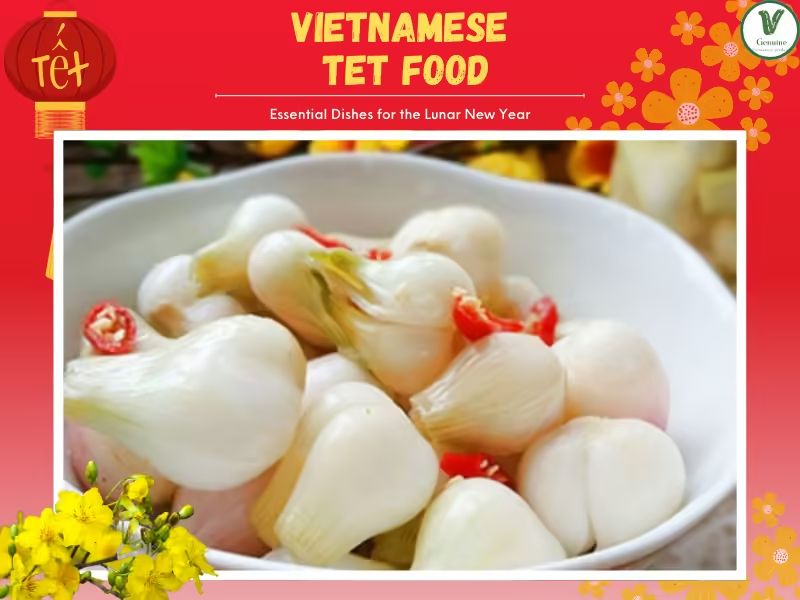
Pickled vegetables
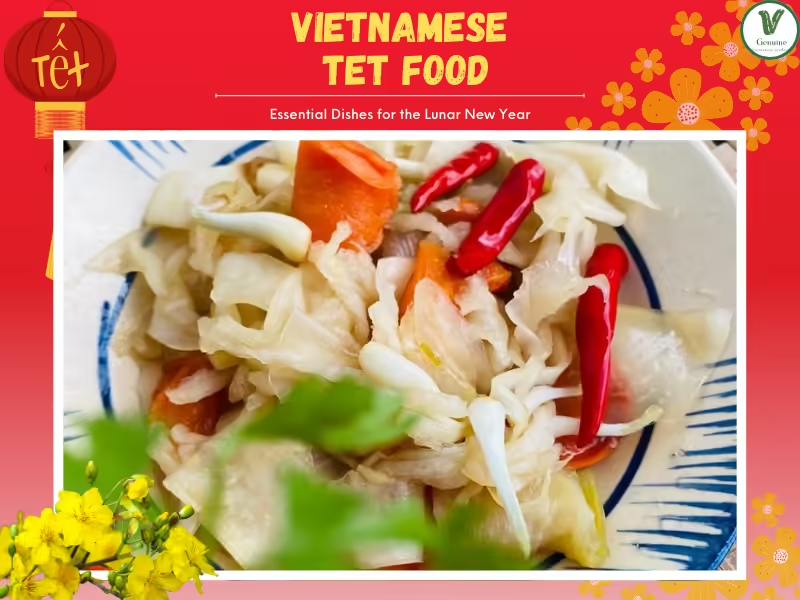
Pickled leeks
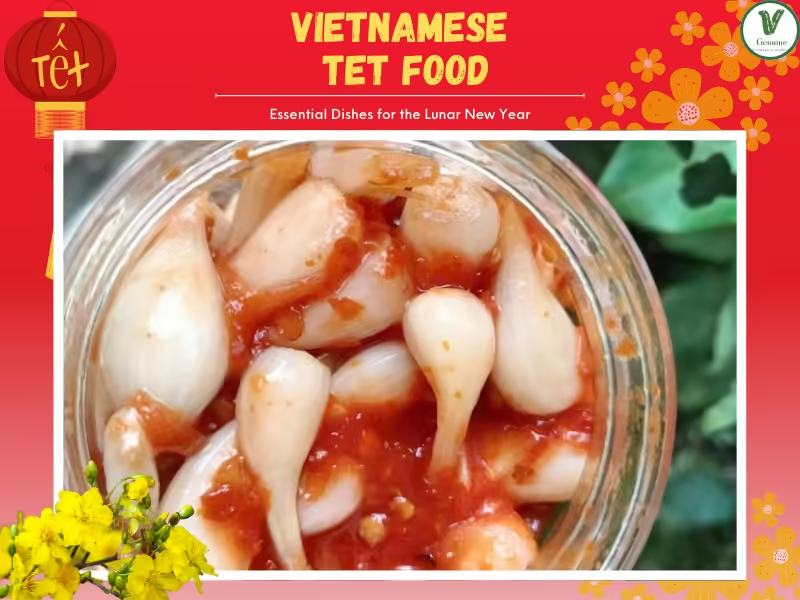
Popular pickled dishes from Northern, Central, and Southern Vietnam. Click the arrows to see more. (Source: Collected)
Overview
Vietnamese name: Dua hanh/ dua mon/ cu kieu
Ingredients for pickled shallots: Shallots, fish sauce, sugar, vinegar, salt
Ingredients for pickled vegetables: Papaya, carrot, white radish, kohlrabi, pickled small leeks, fresh chili peppers, salt, sugar, MSG, fish sauce.
Ingredients for pickled leeks: pickled small leeks, sugar, salt, vinegar, fish sauce
Special equipment: Glass jar
For Vietnamese families, fermented vegetables are a must during Tet. Fermenting gives these dishes a mild, tangy flavor, which is believed to aid digestion and enhance the overall taste of meals, especially when paired with traditional foods like banh chung. Each region in Vietnam has its twist on these pickled dishes:
Pickled shallots (dua hanh): In the North, shallots are the main ingredient. They’re soaked in a mixture of fish sauce, sugar, and vinegar, and stored in glass jars
Pickled vegetables (dua mon): In Central Vietnam, the method is similar, but the ingredients include papaya, carrot, white radish, kohlrabi, and pickled small leeks.
Pickled leeks (cu kieu): In the South, pickled small leeks are soaked in a mixture of fish sauce and sugar.
Pig trotters stewed with dried bamboo shoots
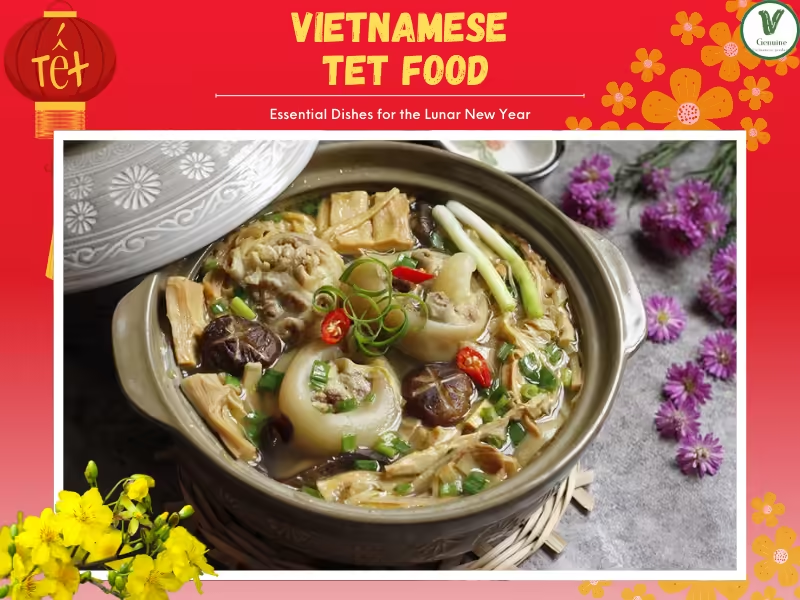
Pig trotters stewed with dried bamboo shoots (Source: Bui Thuy)
Overview
Vietnamese name: Canh mang kho
Ingredients: Dried bamboo shoots, pig trotters, broth mix, black pepper, fish sauce.
Significance: This dish symbolizes family reunion and good fortune
Canh mang kho (Pig trotters stewed with dried bamboo shoots) is a traditional Vietnamese soup, commonly enjoyed during Tet in Northern Vietnam, made with dried bamboo shoots and pig trotters, seasoned with traditional Vietnamese spices. This dish symbolizes family reunion and good fortune.
Bitter melon stuffed with mushroom and pork
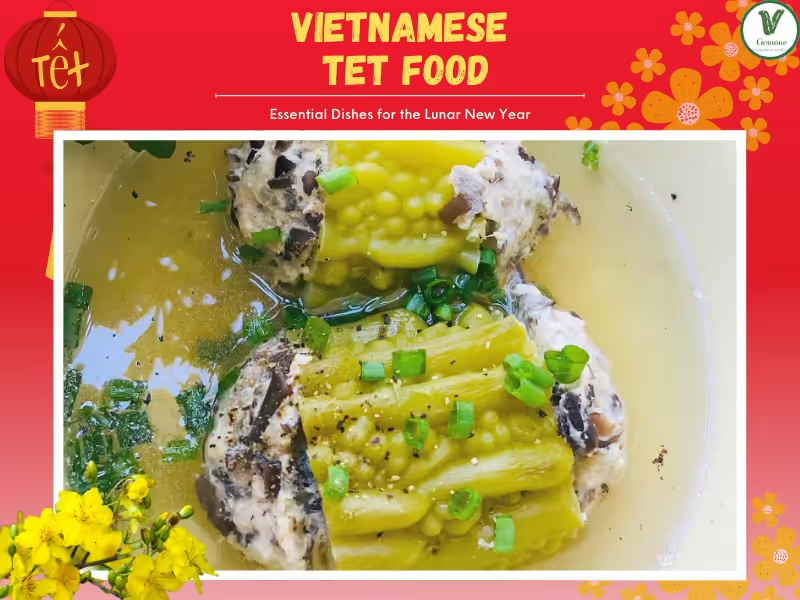
Bitter melon stuffed with mushroom and pork (Source: Collected)
Overview
Vietnamese name: Canh kho qua
Ingredients: Bitter melon, ground pork, wood ear mushrooms, fish sauce, salt, sugar, broth mix, pepper, chili, green onions.
Significance: It symbolizes the hope that all the difficulties of the past year have been overcome
Bitter melon is called ‘kho qua’ in Vietnamese, which symbolizes overcoming hardships and represents hope for a brighter year ahead. To make stuffed bitter melon soup, the chef carefully scoops out the seeds and flesh of the bitter melon and fills it with a mix of ground pork, herbs, and spices. The stuffed melons are then simmered in a flavorful broth until fully cooked.
Jellied meat
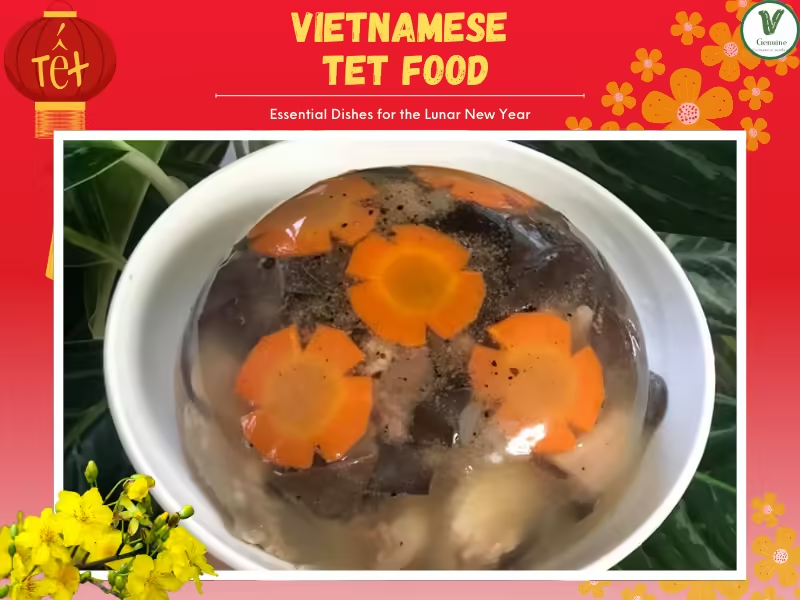
Jellied meat is a popular dish during Tet in Northern Vietnam (Source: Nguyen Thi Thuy Linh)
Overview
Vietnamese name: Thit dong
Ingredients: Pork leg, pork skin, wood ear mushrooms, salt, fish sauce, pepper, monosodium glutamate (MSG), shallots.
Significance: Jellied meat represents the bond, love, and support among family members
Thit dong (jellied meat) is made primarily from pork leg, pork skin, and wood ear mushrooms. To prepare it, the ingredients are marinated with spices and then simmered until tender. Once cooked, the mixture is placed in the refrigerator, allowing it to cool and set into a jelly-like texture. Unlike many dishes, the Vietnamese typically eat it cold, without reheating. This dish is often served alongside rice.
Jellied meat originated in Northern Vietnam, where the climate during Tet is often quite cold. In the past, before refrigerators were available, locals utilized cold weather during the winter months to make this dish.
Some snacks and drinks that Vietnamese people often enjoy during Tet.
Above are some traditional foods for the Vietnamese New Year. We would also like to share information about Tet snacks and drinks that Vietnamese people often enjoy.
Dried candied fruit
Candied ginger
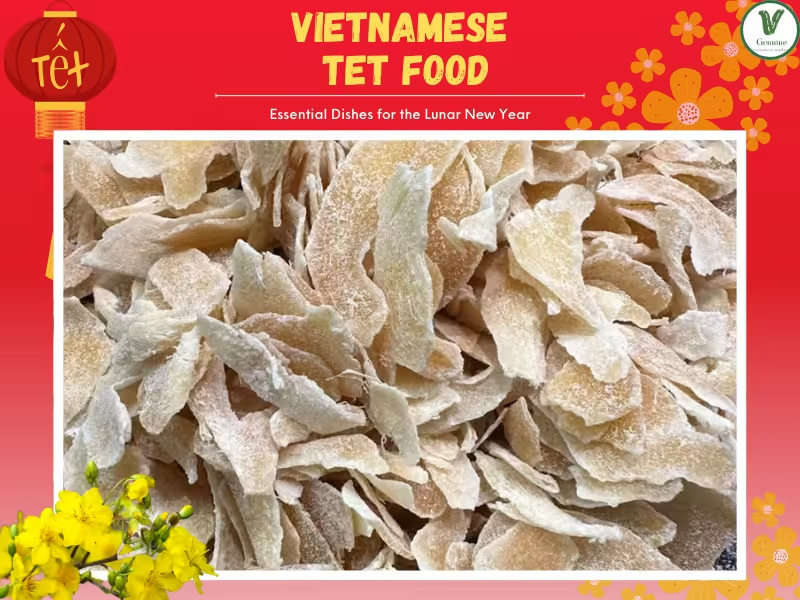
Candied coconut
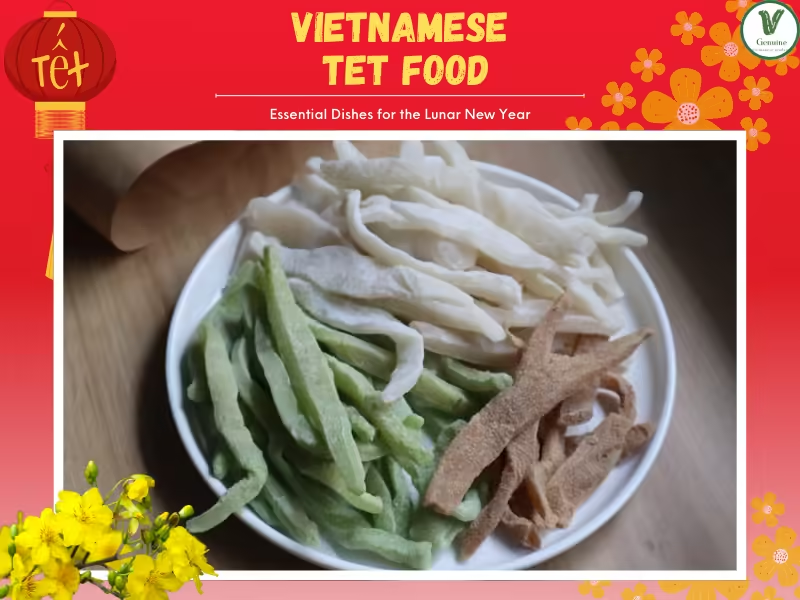
Candied lotus seeds
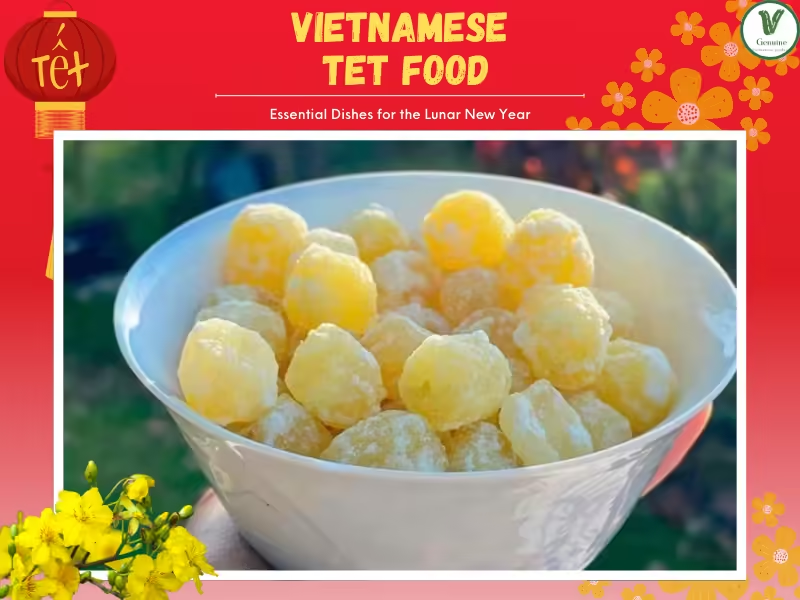
Dried candied fruit is a must-have snack during the Lunar New Year celebration. Click the arrows to see more. (Source: Collected)
Dried candied fruit is an essential snack during the Vietnamese Lunar New Year. Here are some of the most popular types that are enjoyed during Tet.
Candied ginger: Candied ginger is made from fresh ginger and sugar. First, the ginger is peeled, washed, and sliced or julienned into thin pieces. Then, the ginger is added to a pan along with sugar, and everything is stirred together until the sugar crystallizes and coats the ginger evenly. The result is a sweet and spicy snack.
Candied coconut: Similar to candied ginger, coconut meat is sliced into thin strips and mixed with sugar. The mixture is then cooked in a pan and stirred until the sugar crystallizes onto the coconut strips. The result is a fragrant, sweet, and crunchy candied coconut.
Candied lotus seeds: With candied lotus seeds, the process is similar. Vietnamese people mix lotus seeds with sugar, then cook them in a pan, stirring constantly until the sugar evenly coats the seeds and dries thoroughly.
Roasted watermelon seeds
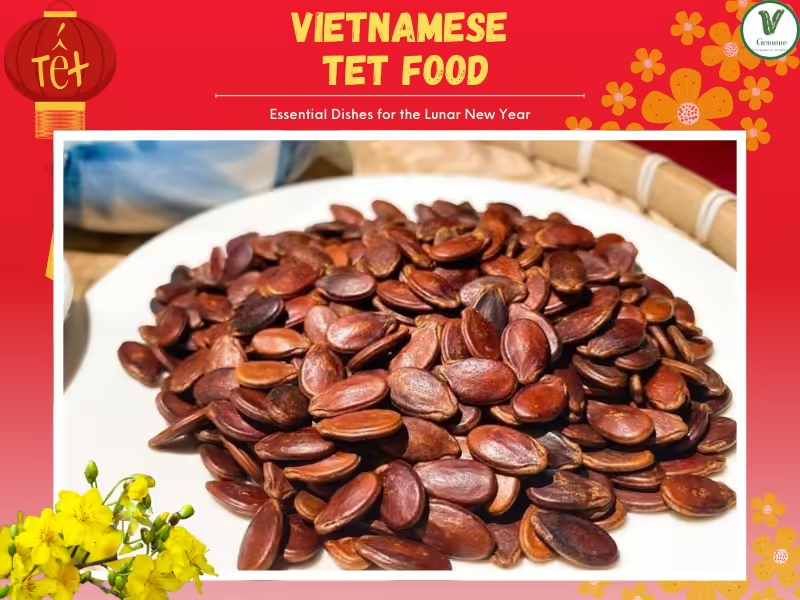
Vietnamese people believe that watermelon seeds bring luck and prosperity (Source: Collected)
Watermelon seeds are one of the most popular snacks during Tet in Vietnam. They’re made by roasting the seeds from watermelons. When eating, Vietnamese people crack open the outer shell with their teeth to enjoy the tasty inner seed.
Vietnamese tea
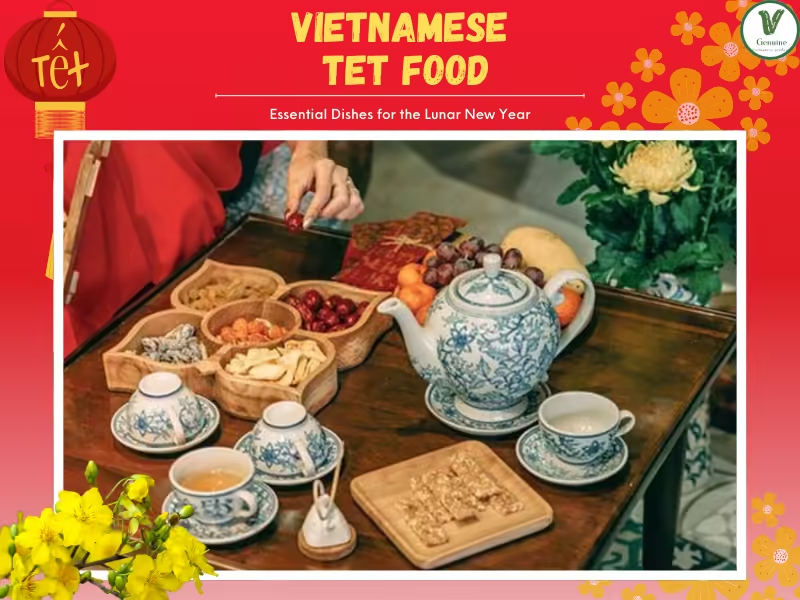
According to tradition, when guests visit during Tet, Vietnamese families often serve them tea, roasted watermelon seeds, and a variety of candied fruits (Source: Collected)
Green tea is a traditional drink during Tet, and Vietnamese people also enjoy some kinds of herbal teas. According to tradition, when you visit a Vietnamese household during the Lunar New Year, the host will offer you candied fruits, watermelon seeds, candies, and tea. It’s a time to share stories of the past year and talk about hopes and plans for the new one.
Key cooking methods and ingredients for Vietnamese Tet food
Cooking methods
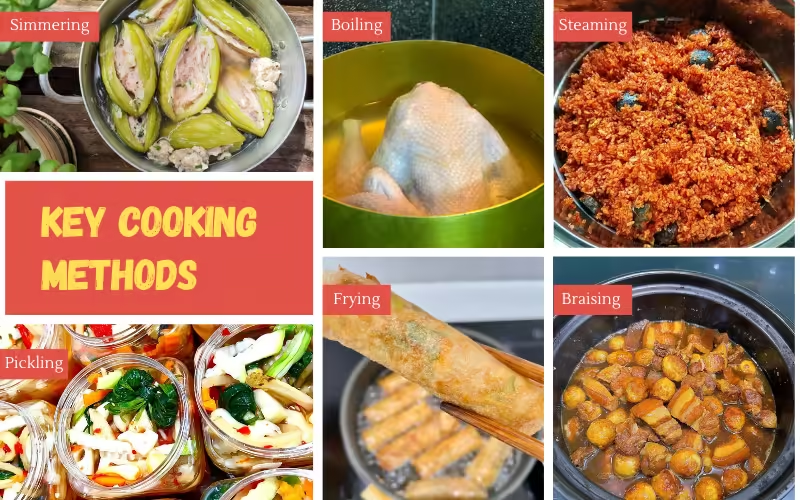
Common cooking methods for Tet in Vietnam
During Tet, Vietnamese people typically prepare their meals using various cooking methods like boiling, steaming, braising, frying, and simmering. The dishes for this holiday are often more elaborate compared to everyday meals, not only ensuring delicious flavors but also emphasizing aesthetic appeal with bright, vibrant colors. Common hues include red, yellow, and green, as these colors are believed to bring luck and happiness in the new year. It’s also common for families to cook in large quantities, storing leftovers in the fridge to enjoy over the next few days.
Spices and herbs for Vietnamese Lunar New Year food
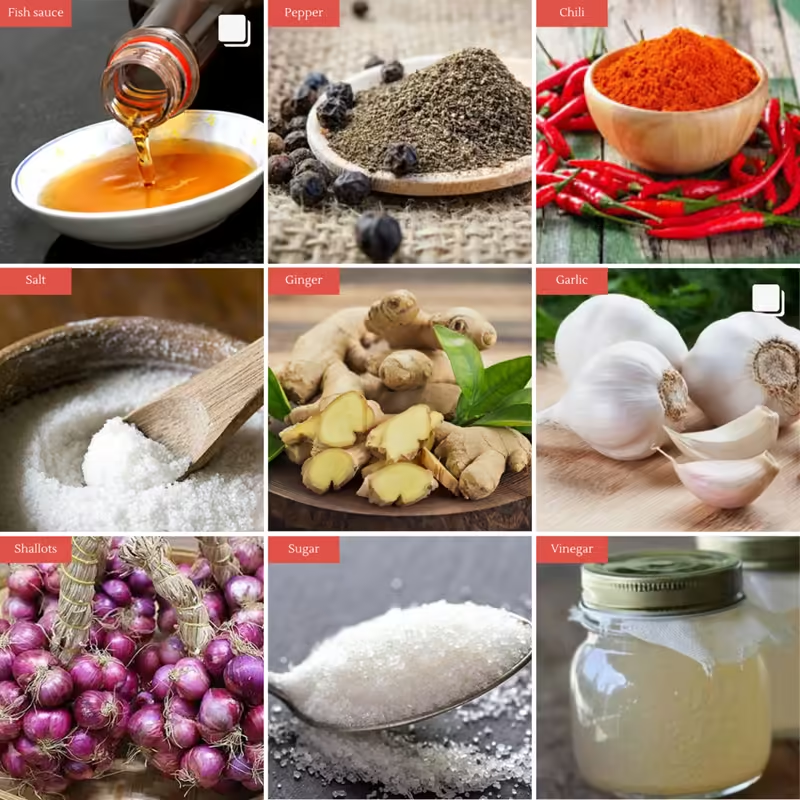
Spices that are commonly used in food for Vietnamese New Year
Spices
In Vietnam, spices play a crucial role in shaping the unique flavors of dishes served during the Lunar New Year celebration. They are so important that people carefully prepare and stock up on them well before Tet to make sure nothing is missing when the holiday arrives. One key ingredient is fish sauce, which is used in almost every dish. It adds depth and richness, giving the food a signature savory taste. Black pepper is another essential spice, enhancing the overall flavor and making the dishes even more flavorful.
Chili adds a spicy kick, bringing warmth and excitement to the meal. Shallots and garlic are often used as key ingredients to create aromatic bases for dishes, providing a fragrant and savory taste. Salt and sugar are also important for balancing the flavors, while vinegar is commonly used to add a touch of tanginess that brightens up the dishes.
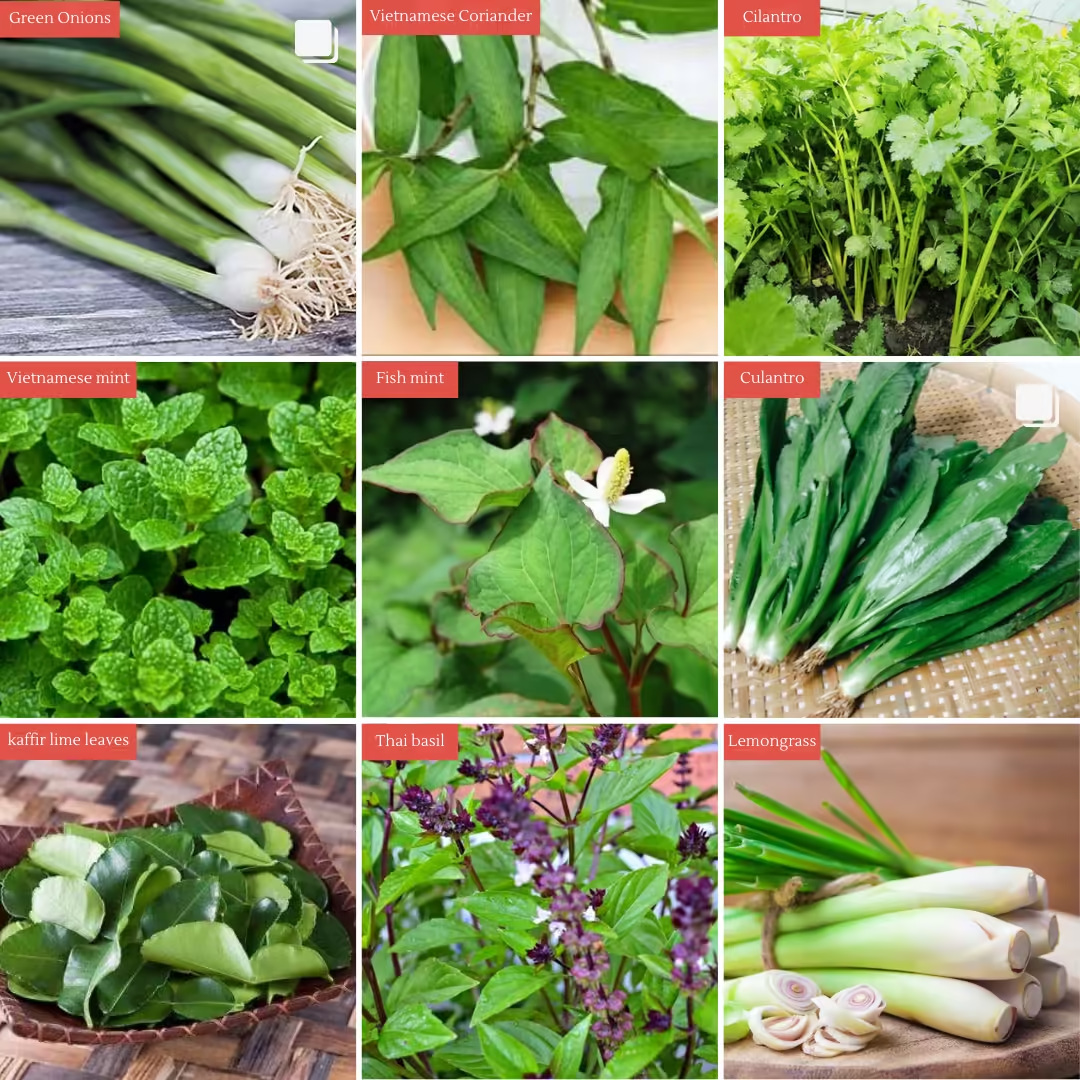
Essential herbs for Vietnamese Tet food
Herbs
Much like spices, herbs are key to bringing out the amazing flavors of traditional Vietnamese dishes during Tet. For example, if you’re making a chicken salad, you’ll definitely want to add some Vietnamese coriander and lime leaves, while green onions are a common garnish in soups, adding both flavor and color. But it’s not just about taste – many Vietnamese people believe that these herbs also offer health benefits and aid digestion.
How Vietnamese people prepare ingredients for Tet foods
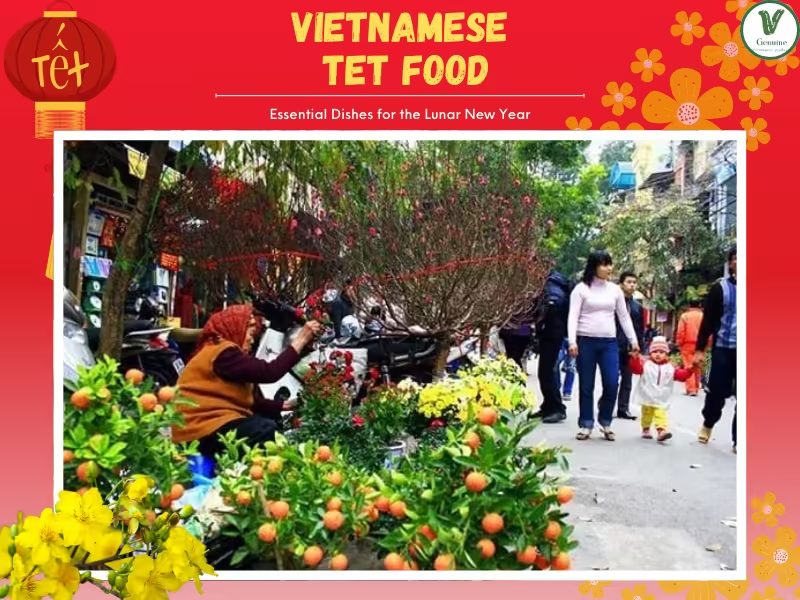
Vietnamese people getting ready for Tet, bustling through markets to stock up on everything they need for the celebration (Source: Collected)
Preparing ingredients for traditional Tet dishes is a meticulous and thoughtful process for the Vietnamese people. They typically start a few weeks in advance to ensure they have ample time for shopping and preparation. Common ingredients include rice, sticky rice, chicken, pork, and beef, along with fresh vegetables and herbs.
Spices play a crucial role as well, with essentials like fish sauce, pepper, garlic, onions, and sugar. The Vietnamese take great care to select the freshest ingredients to guarantee the quality of their meals.
This preparation is not just about cooking; it’s a reflection of their traditions and customs, showcasing their respect for their ancestors and their hopes for a prosperous new year.
Conclusion
We’ve shared some of the most popular Vietnamese Tet foods and the meanings behind each dish. We hope this post has helped you gain a deeper understanding of Vietnamese culture and cuisine. Below, you’ll find a carefully crafted PDF featuring a Vietnamese Tet food menu that you can download for free!
A Video on Traditional Vietnamese Tet Food
Vietnamese Tet food FAQs: What you want to know
Q: What everyday dishes do Vietnamese people avoid during Tet?
A: In Vietnam, people avoid eating duck, shrimp, or squid during Tet because they believe these animals bring bad luck for the new year.
Q: How to eat banh chung?
A: The most common ways to eat banh chung include:
Eat it plain. Or try it with a sprinkle of sugar or a drizzle of honey. Pair it with pickled vegetables for a tangy kick, or fry up banh chung and dip it in chili fish sauce—it’s crispy and delicious!
Q: What leaf is used to wrap banh chung?
A: Banh chung is traditionally wrapped in la dong (phrynium leaves). However, in some regions, banana leaves are used as an alternative
A: What’s the difference between banh chung and banh tet?
A: Banh chung is square-shaped and commonly found in northern Vietnam, while banh tet is cylindrical and popular in central and southern regions. Banh tet can have a filling similar to banh chung or be made without any filling.
Q: Are there any vegetarian or vegan options for Tet?
A: Absolutely! During Tet, there are several delicious vegetarian options that people can enjoy. Vegetarian chung cake, vegetarian Vietnamese pork roll, or vegetarian fried spring rolls, among others.
Bonus: A PDF Guide to Vietnamese Lunar New Year Food
Vietnamese Tet Food PDF Guide
VivaVn Team created this PDF to give you an overview of Vietnamese Lunar New Year food. Inside, you’ll find information on 12 Vietnamese dishes, including:
Vietnamese names
Ingredients
Cooking methods
Significance
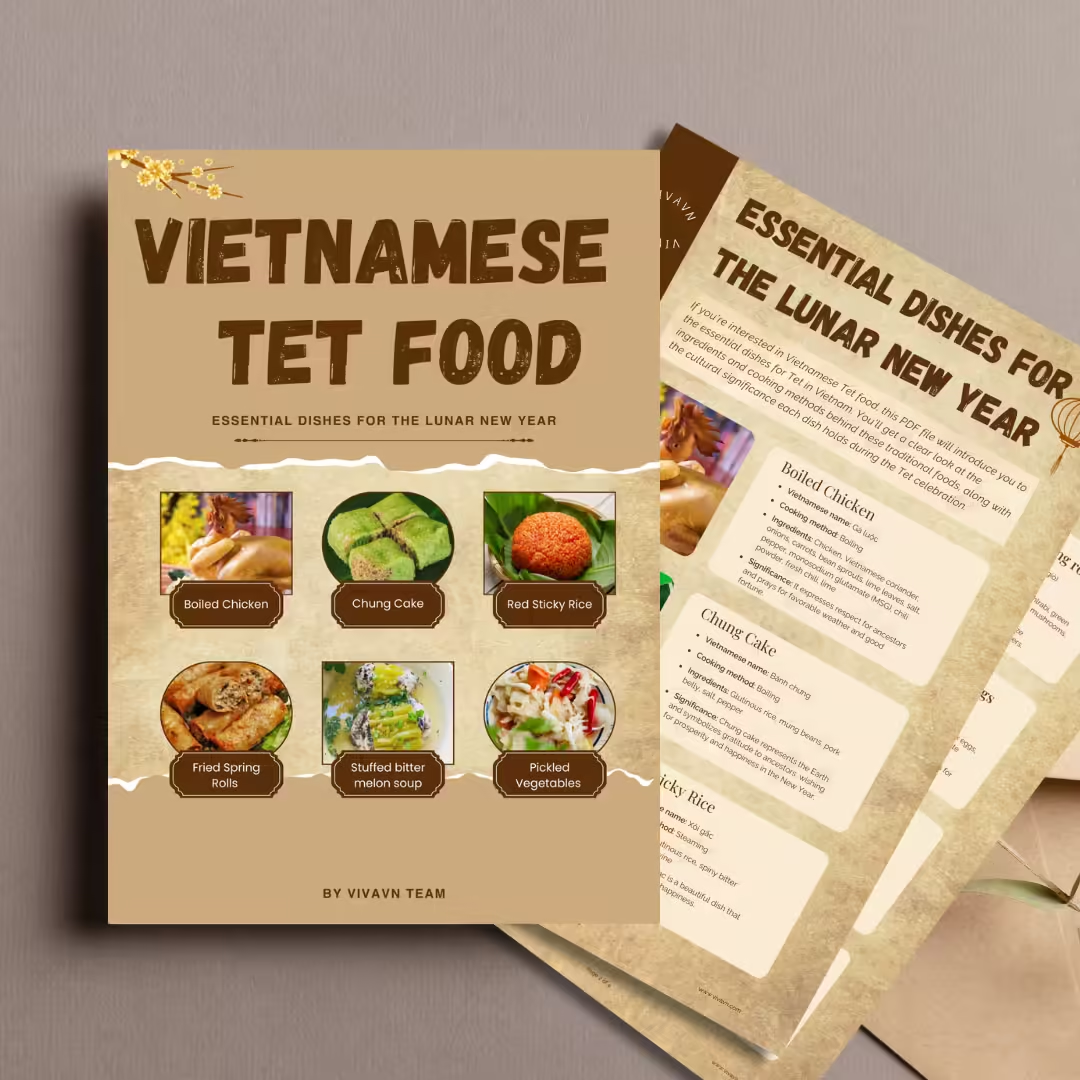
Share on FacebookShare on X (Twitter)Share on PinterestShare on WhatsappShare on LinkedinShare on TelegramShare on Email
- https://www.youtube.com/@VivaVNOfficial
- https://www.facebook.com/vivavnofficial2024
- https://www.pinterest.com/vivavnofficial/
© 2025 VivaVN. All rights reserved.

Leave a Reply